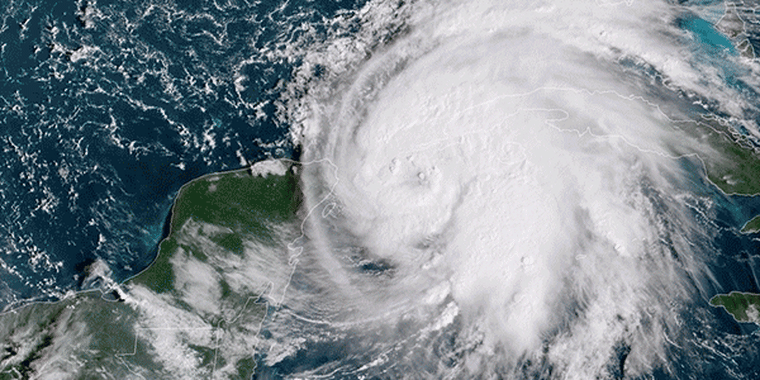The National Hurricane Center declared Tropical Storm Michael a hurricane on Monday morning and said it is expected to strengthen rapidly to a Category 3 in the next 24 to 36 hours.
"Michael could produce three life-threatening hazards along portions of the northeastern Gulf Coast: storm surge, heavy rainfall, and hurricane-force winds, with storm surge and hurricane watches in effect," the NHC tweeted.
The storm initially formed near Mexico's Yucatan Peninsula. The Florida Panhandle and Big Bend region, as well as the Carolinas, are expected to receive "life-threatening" flash flooding through Thursday, according to the hurricane center.
"Let me be clear: Hurricane Michael is a monster storm and the forecast keeps getting more dangerous,” Florida Gov. Rick Scott said Monday evening after being briefed by officials in Escambia County.
He said some areas could see storm surges of 8 to 12 feet, which can travel far inland and potentially cover the roofs of houses. Even in areas outside of the forecast path, deadly storm surges could occur, Scott said. The storm could also produce tornadoes, he said.
"Hurricane Michael is forecast to be the most destructive storm to hit the Florida panhandle in decades,” Scott said.
Scott requested that President Donald Trump declare a pre-landfall emergency for the state.
The governor also expanded his initial emergency declaration from 26 to 35 counties — activating a total of 1,250 National Guard personnel with an additional 4,000 available, and the state will be bringing in an additional 30,000 emergency personnel from neighboring states.
While attending the International Association of Chiefs of Police Annual Convention in Orlando, Florida, on Monday, Scott said, "I want to thank President Trump, we had horrible hurricanes. Trump couldn't have done more than he's done."
Soon after, Trump responded to Hurricane Michael while giving a speech at the same convention.
"As Hurricane Michael nears landfall we are working with state and local officials in Florida to take all necessary precautions," the president said. "I told Rick Scott that we are ready for you. Looks like another big one, but we've handled them well."
Earlier Monday, Scott had said, "Hurricane Michael poses a deadly threat. We have never seen a storm like this hit this part of our state."
A hurricane warning was issued for the Gulf Coast of Florida from the Alabama border east to the Suwannee River, the hurricane center said. The center of the hurricane is expected to move inland over the Florida Panhandle or the Big Bend area on Wednesday, according to the hurricane center.
Alabama Gov. Kay Ivey issued a statewide state of emergency late Monday afternoon in anticipation for possible power outages, wind damage and debris. She warned that the storm could also cause tornadoes and flash flooding, and urged residents to heed warnings and instructions from authorities.
"Alabama is once again in the path of a hurricane, but I know Alabamians will once again come together and be prepared for whatever Michael may bring," Ivey said. "On the state level we are prepared, now is the time for residents in south Alabama to review your emergency preparedness plans and also get prepared."
Last month's Hurricane Florence left surge flooding in North Carolina, record flooding in South Carolina as well as high tide in the coast of Virginia. The hurricane left a total of at least 49 dead in the three states, with North Carolina having the highest toll with 39 fatalities.
When Florence made landfall from the Atlantic in September, the cities along the coast in North Carolina faced the hardest initial impact. The days following the hurricane are when storm surge, flooding and loss of electricity began to hit more inland.
In the city of New Bern, North Carolina, more than 1,200 residents fled to shelters upon mandatory evacuation announcements. Many residents returned to extensive damage to their homes and are still working with local and federal agencies to rebuild as they are now in Hurricane Michael's path.
"It's very important not to concentrate just on that path, but the impact of the rain on the surrounding areas," Ken Graham, director for NHC said in a Facebook Live. "One of the biggest impacts is the storm surge that comes which causes half of the fatalities in these types of storms."
Graham said that Tallahassee and central parts of Georgia could receive as much as 6 to 10 inches of rain by midweek.
Florida State University campuses in Tallahassee and Panama City are set to close Monday night and remain shuttered through Friday.
Florida's Gulf County issued mandatory evacuations for all of Cape San Blas, the entire Indian Pass area as well as Simmons Bayou, Highland View, Windmark, portions of the City of Port St. Joe, St. Joe Beach and Beacon Hill. Voluntary evacuation orders were issued for parts of Hernando, Leon, Liberty and Santa Rosa counties, Scott's office said. In some of those orders, people in mobile home parks and low-lying areas were urged to leave.
Shelters are set to open Tuesday morning and sand bags will be provided for residents. The county's schools are closed from Tuesday till Wednesday, Oct. 17.
"[Florida] families need to get ready for this storm RIGHT NOW," Scott tweeted on Monday.


